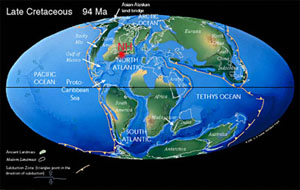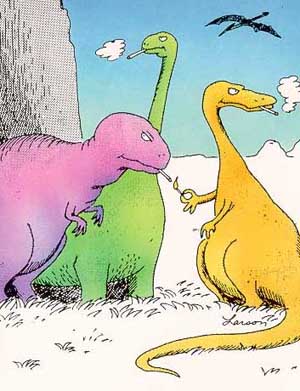A Brave New World
Geologic activity during the Cretaceous Period
in New Hampshire was basically a continuation of events and processes
that occured in the previous Jurassic Period.
Magma from the
Earth's interior continued taking advantage of the weak spots in the
crust created by the rifting of Pangea.
The infant Atlantic Ocean continued to grow and widen. The
Earth was reshaping itself into a brave new world - again.
New Hampshire was firmly
attached to North America and all of the major landscape creation was
completed - with one major exception:
weathering and erosion kept up
their non-stop work in the middle of a 180 million year episode of
activity which continues today.
Another Big
Bang?
While there was the constant
tedium of about 75 million years of just weathering and erosion shaping
the New Hampshire landscape, something dramatic was about to happen,
not just to New Hampshire, but to the whole world.
A doomsday asteroid or comet was
on a collision course with what is today the Yucatan Peninsula of
Mexico. The resulting ash and smoke clouds from the vaporization
of a portion of the planet's crust and its forests for thousands of
miles around blocked out the Sun's light and heat. This
caused extended winter like conditions to take hold on a planet whose
dominant animal life form, the dinosaur, relied on the sun's heat to
warm their climate and their bodies so they could live. The
Sun's light and heat also allowed plants to grow.
No light and heat -no food for
plant eating dinosaurs.
No plant eating dinosaurs - no
meat for meat eating dinosaurs.
No plant eating or meat eating
dinosaurs - no more dinosaurs.
No more dinosaurs - no more Cretaceous Period.
|
|
| Goodbye Pangea, Hello Atlantic
Ocean |
|
Below is a map of how the
Earth is thought to have looked during the Cretaceous Period.
Pangea is broken up, the Atlantic Ocean is
widening and the present day shape of the continents and their
respective tectonic plates are starting to look familiar.

(Click on the image for a closer look.)
Image Credit:
Christopher Scotese; scotese.com
|
| What Really Happened To The
Dinosaurs? |
|
Most scientists - and the
general public - believe an asteroid or comet colliding with the Earth
caused the extinction of the dinosaurs. But since no people were
around to witness this event (good thing too, or we would have become
extinct with the dinosaurs!), we'll never know for absolutely sure what
wiped them out. Below is cartoonist Gary Larsen's explanation for
the demise of the dinosaurs.

The Far Side, by Gary Larson,
copyrighted 1982,1984 Chronicle Features.
|
|